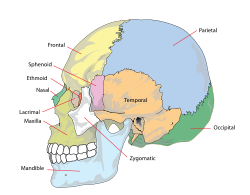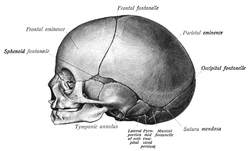| Skull | |
|---|---|
 Volume rendering of a human head skull from side | |
| Details | |
| System | Skeletal system |
| Identifiers | |
| MeSH | D012886 |
| FMA | 54964 |
| Anatomical terminology | |
The skull, or cranium, is typically a bony enclosure around the brain of a vertebrate. [1] [2] In some fish and amphibians, the skull is of cartilage. The skull is at the head end of the vertebrate.
Contents
- Structure
- Humans
- Other vertebrates
- Tetrapods
- Development
- Clinical significance
- Injuries and treatment
- Transgender procedures
- Society and culture
- Osteology
- Sexual dimorphism
- Craniometry
- Terminology
- History
- Additional images
- See also
- References
- External links
In the human, the skull comprises two prominent parts: the neurocranium and the facial skeleton, [3] which evolved from the first pharyngeal arch. The skull forms the frontmost portion of the axial skeleton and is a product of cephalization and vesicular enlargement of the brain, with several special senses structures such as the eyes, ears, nose, tongue and, in fish, specialized tactile organs such as barbels near the mouth. [4]
The skull is composed of three types of bone: cranial bones, facial bones and ossicles, which is made up of a number of fused flat and irregular bones. The cranial bones are joined at firm fibrous junctions called sutures and contains many foramina, fossae, processes, and sinuses. In zoology, the openings in the skull are called fenestrae, the most prominent of which is the foramen magnum, where the brainstem goes through to join the spinal cord.
In human anatomy, the neurocranium (or braincase), is further divided into the calvaria and the endocranium, together forming a cranial cavity that houses the brain. The interior periosteum forms part of the dura mater, the facial skeleton and splanchnocranium with the mandible being its largest bone. The mandible articulates with the temporal bones of the neurocranium at the paired temporomandibular joints. The skull itself articulates with the spinal column at the atlanto-occipital joint. The human skull fully develops two years after birth.
Functions of the skull include physical protection for the brain, providing attachments for neck muscles, facial muscles and muscles of mastication, providing fixed eye sockets and outer ears (ear canals and auricles) to enable stereoscopic vision and sound localisation, forming nasal and oral cavities that allow better olfaction, taste and digestion, and contributing to phonation by acoustic resonance within the cavities and sinuses. In some animals such as ungulates and elephants, the skull also has a function in anti-predator defense and sexual selection by providing the foundation for horns, antlers and tusks.
The English word skull is probably derived from Old Norse skulle, [5] while the Latin word cranium comes from the Greek root κρανίον (kranion).

















